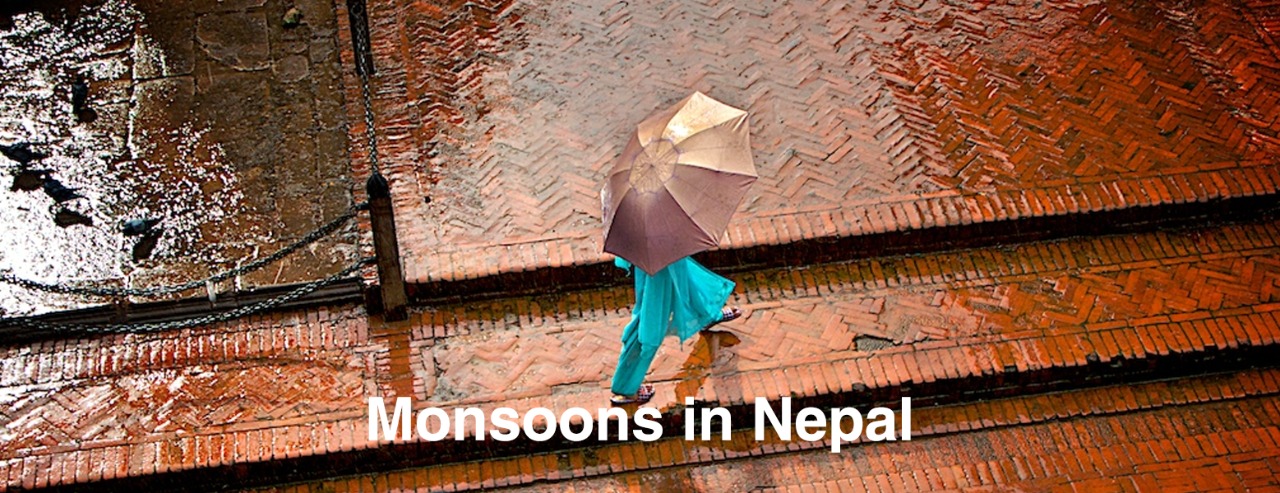We experience five seasons in Nepal every year. The seasons in Nepal are spring, summer, monsoon, autumn, and winter. In this article, we will discuss at length the monsoon season in Nepal, and how to make it more enjoyable by preventing ourselves and our loved ones from the common monsoon diseases.
During monsoon months, we encounter downpours on a daily basis along with occasional thunderstorms. Further, heavy rains & landslides make many places close down. The amount of rainfall and temperature during monsoon season varies from one part of the country to another. For example, in Kathmandu Valley, the average annual rainfall is 55 inches, while the amount of downpour is around 100 inches in Pokhara Valley.
Usually, the monsoon arrival date in Nepal is 10th June. And the season continues to 23rd September. However, sometimes, the date of arrival can differ. For example, the monsoon arrived late in Nepal by 10 days and 2 days in 2019 and 2020, respectively. On the other hand, it arrived two days earlier in 2018.
Even in 2021, the monsoon has come to Nepal a little earlier, compared to the forecasted data of arrival, 13th June. In a report published in The Kathmandu Post on 11th June 2021, meteorologist Pradhanang said, “Every ten years, the monsoon arrival date is updated so we can say we are two days early this time.”
The importance of monsoon in Nepal is huge as it is the lifeline of agriculture and biodiversity in the country. However, we cannot overlook the hazardous risk during monsoon as 116 people died and 50 went missing in the landslides and floods induced by heavier than usual rainfall in 2020. According to the Department of Meteorology and Hydrology of the Nepal Government, Nepal had 736mm of rainfall from the beginning of the monsoon till the middle of June.
Despite the above-listed deterrents, still there are several ways in which we can enjoy the monsoons in our beautiful country! Let’s explore some options here:
Rains bring a sense of happiness, beauty, and youthfulness to most. You could marvel at the beauty of nature visiting some of the heritage sites like Kathmandu Durbar Square, Bhaktapur, Patan, and Thimi with family for a quick outing or maybe explore your youthful side and get more adventurous with White Water Rafting in the Raging Trishuli as the river swells in the monsoons. The breath-taking scenic beauty you get to experience as you go down the river is definitely an added bonus.
Another place we love to visit during monsoons is Pokhara, as we get to take part in various adventure sports, including paragliding, ultra flying, zip-lining, hot air ballooning, boating, kayaking, mountain biking, and day-hiking. We have also seen many people trekking to Upper Mustang, Jomsom Muktinath, and Short Everest Base Camp during monsoon and rainfall.
If you are up for a day-hike in Kathmandu, you will get to visit Chandragiri, Bungamati and Khokana, Budhanilkantha, Nagi Gumba, Nagarkot, and Panauti.
Monsoons bring out the kids in most of us as we marvel at nature in all its glory. However, the season also brings various viral infections, water-borne infections, mosquito-borne infections, and air-borne infections with it. Incessant rainfalls, floods, landslides and non-functional sanitation systems are further trigger for the prevalent diseases in this season. So, it’s important to understand what these diseases and how we can be better prepared to prevent ourselves from them.
According to a Nature Public Health Emergency Collection report, the two most common monsoon diseases are typhoid and dengue fever. As per the Epidemiological Disease Control Division (EDCD) of the Government of Nepal, in 2019, there were 17,992 dengue cases reported in sixty-eight districts of Nepal. On the other hand, according to a 2017 report, Nepal reported 351 estimated typhoid cases per 10,000 people in 2017.
Typhoid, cholera, gastroenteritis, diarrhea, and jaundice are monsoon health hazards that affect us, owing to food and water contamination. Especially, people living in congested and poorly-sanitized areas are highly exposed to these health issues. Further, many people suffer from viral infections, colds, and flu, as the increased moisture in the air boosts virus transmission.
The most prominent symptoms of typhoid are fever, stomach pain, headache, diarrhea/constipation, loss of appetite, and cough. At the same time, people affected by cholera suffer from watery stool, vomiting, thirst, dehydration, cramps, and stomach irritation. We have also seen a surge in jaundice cases in the rainy season with health issues, such as fever, abdominal pain, chills, yellowish skin, dark urine, clay color stool, and flu-like symptoms.
Gastroenteritis, being another serious health concern in the monsoon, makes people suffer from abdominal pain, abdominal cramps, and diarrhea. Further, diarrhea itself is a water-borne disease that comes with problems like watery stool, fever, abdominal pain/cramps, and bleeding stool.
The advent of monsoon also increases the spread of mosquito-borne diseases, such as encephalitis, meningitis, dengue, malaria, and Japanese encephalitis. Inland water bodies and stagnant water during the monsoon work as the breeding ground for the mosquitoes.
Dengue has always been a matter of worry and concern for us in the rainy seasons. High fever, muscle pain, cramps, nausea, vomiting, and rashes are the common symptoms of dengue. In malaria, people suffer from high temperature, chills, headaches, vomiting, shivering, muscle pains, and diarrhea.
Encephalitis makes people suffer from fever, seizures, neck stiffness, movement problems, and unconsciousness. On the other hand, Japanese encephalitis comes with the symptoms of fever, weakness, vomiting, neurological problems, headache, seizures, and movement disorders. Meningitis is another mosquito-borne disease that is known to have traits like high temperature with cold feet and palms, muscle and joint pain, vomiting, spots or rashes, and pale or blotchy skin.
One of the major air-borne infections during monsoons in Nepal is an acute respiratory infection. Situations worsen when people in flooded areas are shifted to makeshift shelters. There, people have limited access to nutritious food, clean water, and they are hardly in a condition to fight pollution. As a result, they become vulnerable to respiratory problems. The acute respiratory infection comes with nasal and lungs congestion, runny nose, body ache, fatigue, sore throat, and cough.
Things have become worse with the breakout of Covid-19 in 2020. With the focus shifting to provide people with necessary medical assistance in Covid-19 cases, we have experienced that preventive activities against seasonal diseases are being compromised.
We can see that similar thoughts are echoed in the press release published by the International Federation of Red Cross and Red Crescent Societies (IFRC) on 6th Auguest, 2020. In that press release, Dr. Abhishek Rimal, Regional Emergency Health Coordinator, Asia Pacific, says, “The critical focus on saving lives in this pandemic and preventing the further spread of COVID-19 has diverted their resources from prevention activities such as dengue and malaria are going untreated. We are seeing evidence that people are reluctant to go to health facilities because they fear catching COVID-19 and getting more sick.”
So, it’s time that we become aware and spread awareness amongst people around us. We can take some preventive and precautionary measures for maintaining good health and keeping all these diseases at bay. The first things that we should be careful about are avoiding water stagnation to stop mosquito breeding and making sure that the sanitation system in our house or locality is working properly.
Doctors advise drinking boiled and purified water during rainy seasons to avoid infections. Further, they advise us to eat food rich in vitamin C, minerals, and other micro-nutrients for better immunity. Along with these, we will also have to take care of basic hygienic practices, including keeping the bathroom and toilette clean and washing foods and vegetables properly. Moreover, as full-proof protection against diseases such as typhoid, dengue, cholera, Japanese encephalitis, and Covid-19, we should get vaccinated.
Also, we can grow habits of wearing masks if we have a cold or flu and avoid visiting crowded places. Finally, in these days of the pandemic, we have to follow Covid-19 protocols to avoid further hazards.
Nepal as a country follows the WHO guidelines regarding the prevention, management, and control of dengue and other major diseases in the country. So, even if we fall sick, we should seek advice from doctors and government health organizations. And we should never take any medicine without consulting a doctor.
In case you are suffering from any of the common monsoon diseases, you can also get in touch with your local pharmacist at any of the Pharmalife Pharmacies, across the country. Pharmalife is a conglomeration of healthcare stores in Kathmandu. With an AI-induced digital infrastructure, we are on our way to integrate over 2000 pharmacies across all of Nepal. We further operate with the motto of making medicines easily accessible to everyone at an affordable rate. Moreover, we are dedicated to building a strong network of trained staff to only offer the best medical product to the customers.


There are no comments